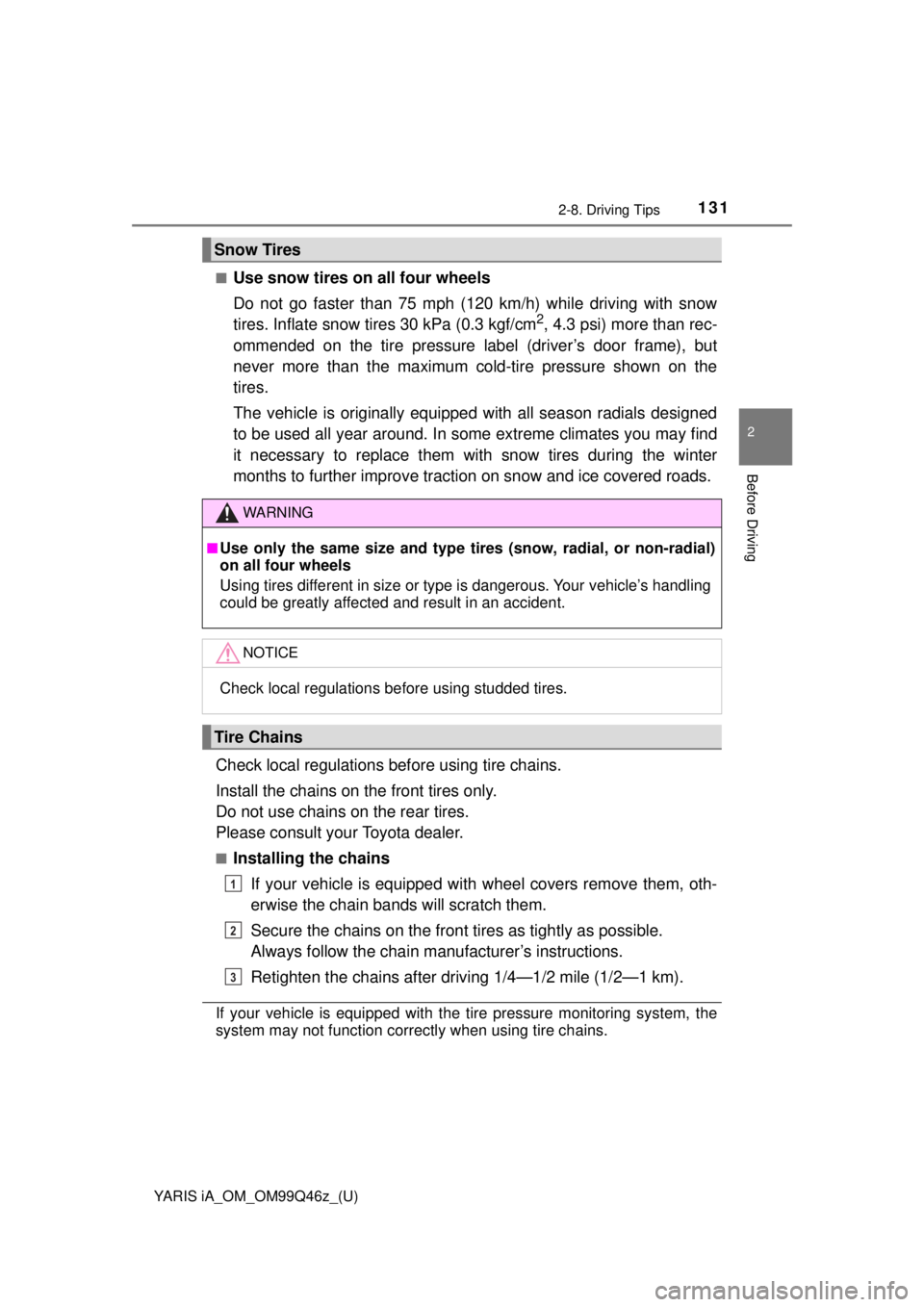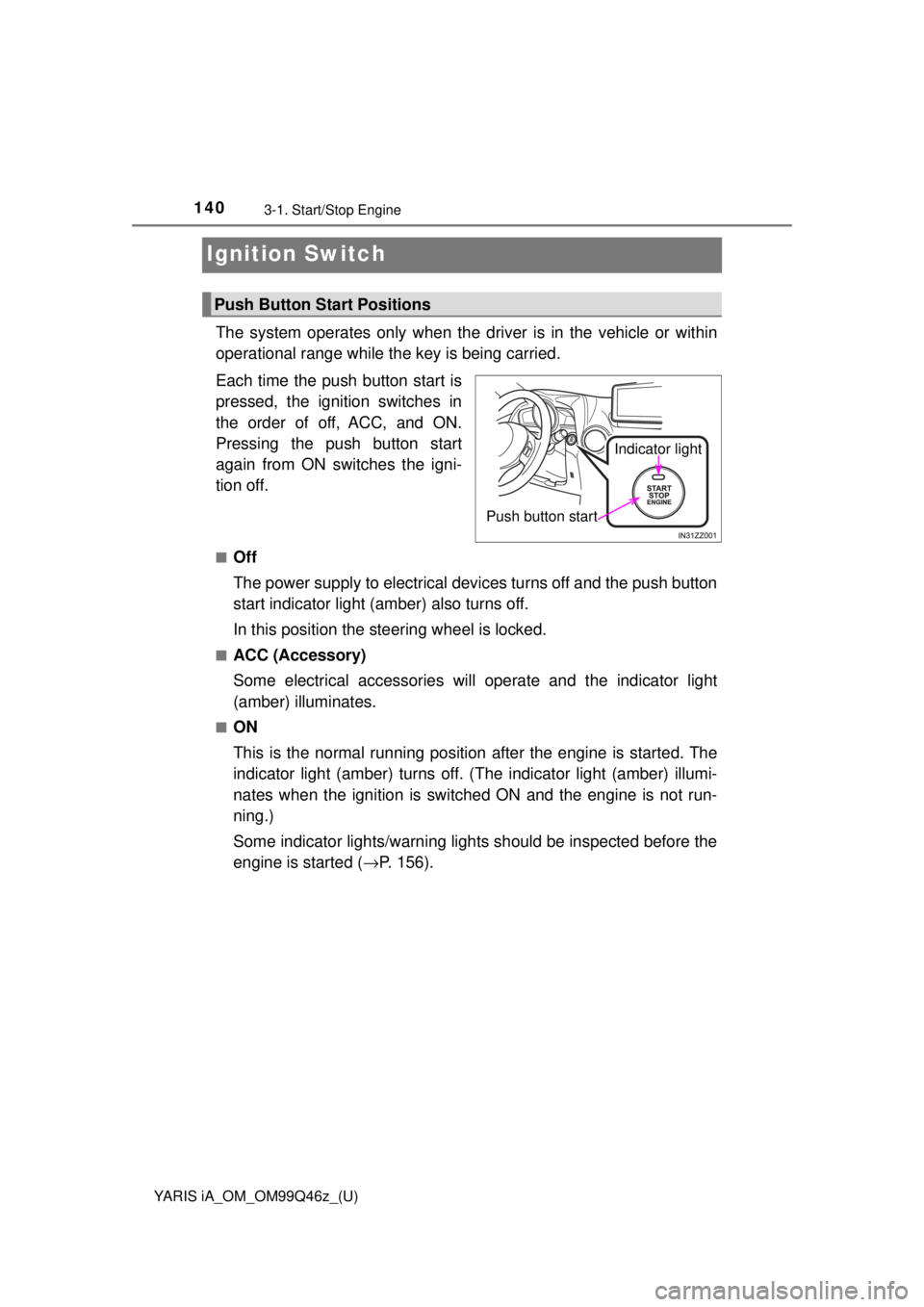Page 129 of 576
129
YARIS iA_OM_OM99Q46z_(U)
2-8. Driving Tips
2
Before Driving
Rocking the Vehicle
If you must rock the vehicle to free it from snow, sand or mud, depress
the accelerator slightly and slowly move the shift lever from 1 (D) to R.
WARNING
■Do not spin the wheels at more th an 35 mph (56 km/h), and do not
allow anyone to stand behind a wheel when pushing the vehicle
When the vehicle is stuck, spinning the wheels at high speed is dangerous.
The spinning tire could overheat and explode. This could cause serious
injuries.
NOTICE
Too much rocking may cause engine overheating, transaxle failure, and tire
damage.
Page 131 of 576

YARIS iA_OM_OM99Q46z_(U)
1312-8. Driving Tips
2
Before Driving
■Use snow tires on all four wheels
Do not go faster than 75 mph (120 km/h) while driving with snow
tires. Inflate snow tires 30 kPa (0.3 kgf/cm
2, 4.3 psi) more than rec-
ommended on the tire pressure label (driver’s door frame), but
never more than the maximum cold-tire pressure shown on the
tires.
The vehicle is originally equipped with all season radials designed
to be used all year around. In some extreme climates you may find
it necessary to replace them with snow tires during the winter
months to further improve traction on snow and ice covered roads.
Check local regulations bef ore using tire chains.
Install the chains on the front tires only.
Do not use chains on the rear tires.
Please consult your Toyota dealer.
■Installing the chains If your vehicle is equipped with wheel covers remove them, oth-
erwise the chain bands will scratch them.
Secure the chains on the front tires as tightly as possible.
Always follow the chain manufacturer’s instructions.
Retighten the chains after driv ing 1/4—1/2 mile (1/2—1 km).
If your vehicle is equipped with the tire pressure monitoring system, the
system may not function correctly when using tire chains.
Snow Tires
WARNING
■Use only the same size and type tires (snow, radial, or non-radial)
on all four wheels
Using tires different in size or type is dangerous. Your vehicle’s handling
could be greatly affected and result in an accident.
NOTICE
Check local regulations before using studded tires.
Tire Chains
1
2
3
Page 132 of 576
132
YARIS iA_OM_OM99Q46z_(U)
2-8. Driving Tips
WARNING
■Driving with tire chains
● Chains may affect handling.
● Do not go faster than 30 mph (50 km/h) or the chain manufacturer’s rec-
ommended limit, whichever is lower.
● Drive carefully and avoid bumps, holes, and sharp turns.
● Avoid locked-wheel braking.
NOTICE
●Do not use chains on a temporary spare tire; it may result in damage to the
vehicle and to the tire.
● Do not use chains on roads that are free of snow or ice. The tires and
chains could be damaged.
● Chains may scratch or chip aluminum wheels.
Page 133 of 576
133
YARIS iA_OM_OM99Q46z_(U)
2-8. Driving Tips
2
Before Driving
Driving In Flooded Area
WARNING
■Dry off brakes that have become wet by driving slowly, releasing the
accelerator pedal and lightly applyi ng the brakes several times until
the brake performance returns to normal
Driving with wet brakes is dangerous. Increased stopping distance or the
vehicle pulling to one side when braking could result in a serious accident.
Light braking will indicate whether the brakes have been affected.
NOTICE
Do not drive the vehicle on flooded roads as it could cause short circuiting
of electrical/electronic parts, or engine damage or stalling from water
absorption. If the vehicle has been immersed in water, consult your Toyota
dealer.
Page 134 of 576
134
YARIS iA_OM_OM99Q46z_(U)
2-8. Driving Tips
Overloading
WARNING
■Be careful not to overload your vehicle
The gross axle weight rating (GAWR) and the gross vehicle weight rat-
ing (GVWR) of the vehicle are on the Motor Vehicle Safety Standard
Label on the driver’s door frame. Exceeding these ratings can cause an
accident or vehicle damage. You can estimate the weight of the load by
weighing the items (or people) before putting them in the vehicle.
Page 139 of 576

139
YARIS iA_OM_OM99Q46z_(U)
3When Driving
3-1. Start/Stop EngineIgnition Switch ................... 140
Starting the Engine ........... 142
Turning the Engine Off ...... 147
3-2. Combination Meter and Display
Meters and Gauges .......... 148
Warning/Indicator Lights .............................. 156
3-3. Transaxle Manual Transaxle Operation ........................ 160
Automatic Transaxle Controls........................... 164
3-4. Switches and Controls Lighting Control ................. 175
Fog Lights ......................... 179
Turn and Lane-Change Signals ............................ 180
Windshield Wipers and Washer..................... 182
Rear Window Defogger ......................... 185
Hazard Warning Flasher ............................ 186
3-5. Brake Brake System .................... 187
Hill Launch Assist (HLA) ... 191 3-6. ABS/TCS/DSC
Antilock Brake System (ABS) .............................. 193
Traction Control System (TCS) .............................. 194
Dynamic Stability Control (DSC) .............................. 196
3-7. Fuel Economy Monitor Fuel Economy Monitor ...... 199
3-8. Drive Selection Drive Selection (Automatic Transaxle) ..... 201
3-9. Power Steering Power Steering ................. 203
3-10. Active Safety System Active Safety System ........ 204
Smart City Brake Support (SCBS)............................ 205
Laser Sensor..................... 211
3-11. Cruise Control Cruise Control ................... 213
3-12. Tire Pressure Monitoring System
Tire Pressure Monitoring System ............................ 218
3-13. Rear View Monitor Rear View Monitor ............ 222
Page 140 of 576

140
YARIS iA_OM_OM99Q46z_(U)
3-1. Start/Stop Engine
Ignition Switch
The system operates only when the driver is in the vehicle or within
operational range while the key is being carried.
Each time the push button start is
pressed, the ignition switches in
the order of off, ACC, and ON.
Pressing the push button start
again from ON switches the igni-
tion off.
■Off
The power supply to electrical devices turns off and the push button
start indicator light (amber) also turns off.
In this position the steering wheel is locked.
■ACC (Accessory)
Some electrical accessories will operate and the indicator light
(amber) illuminates.
■ON
This is the normal running position after the engine is started. The
indicator light (amber) turns off. (The indicator light (amber) illumi-
nates when the ignition is switched ON and the engine is not run-
ning.)
Some indicator lights/warning li ghts should be inspected before the
engine is started ( →P. 156).
Push Button Start Positions
Push button start Indicator light
Page 141 of 576

YARIS iA_OM_OM99Q46z_(U)
1413-1. Start/Stop Engine
3
When Driving
■Push Button Start Positions
●The engine starts by pressing the push button start while depressing the
clutch pedal (manual transaxle) or the brake pedal (automatic transaxle). To
switch the ignition position, press the push button start without depressing
the pedal.
● Do not leave the ignition switched ON while the engine is not running. Doing
so could result in the battery going dead. If the ignition is left in ACC (For
automatic transaxle, the selector lever is in the P position, and the ignition is
in ACC), the ignition switches off automatically after about 25 minutes.
■ ACC (Accessory)
The keyless entry system does not function while the push button start has
been pressed to ACC, and the doors will not lock/unlock even if they have
been locked manually.
■ ON
When the push button start is pressed to ON, the sound of the fuel pump
motor operating near the fuel tank can be heard. This does not indicate an
abnormality.
WARNING
■Before leaving the driver’s seat, set the parking brake, make sure the
selector lever is in 1st gear or R (manual transaxle) or in P (automatic
transaxle), and always switch the ignition off
Leaving the driver’s seat without setting the parking brake, shifting the
selector lever to 1st gear or R (manual transaxle) or to P (automatic tran-
saxle), and switching the ignition off is dangerous. Unexpected vehicle
movement could occur which could result in an accident.
In addition, if your intention is to l eave the vehicle for even a short period, it
is important to switch the ignition off, as leaving it in another position will dis-
able some of the vehicle’s security systems and run the battery down.